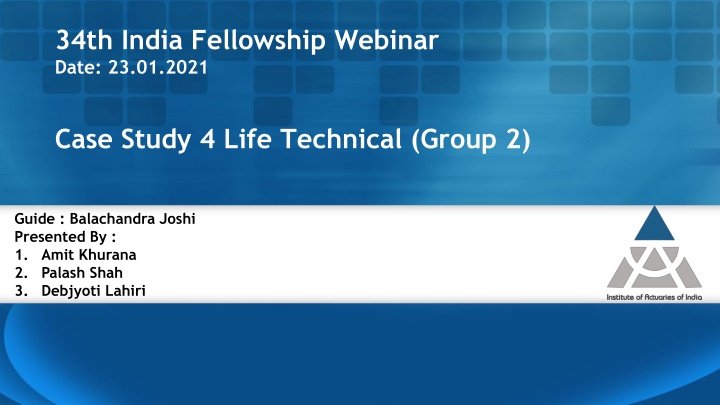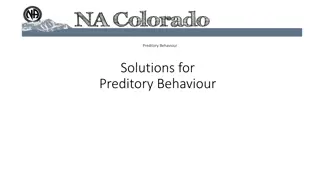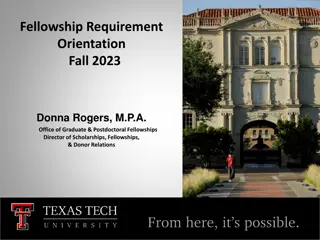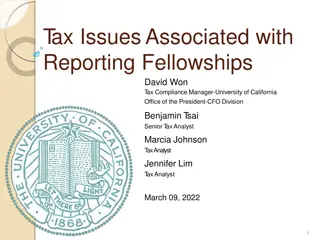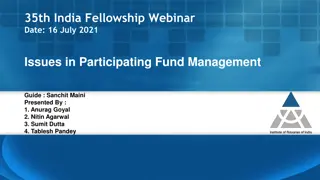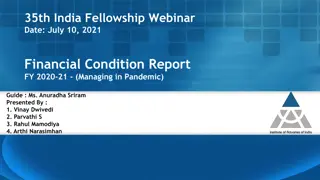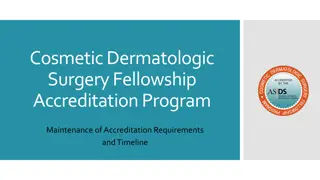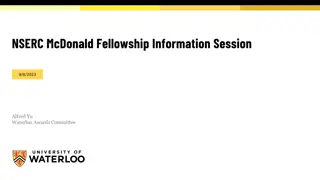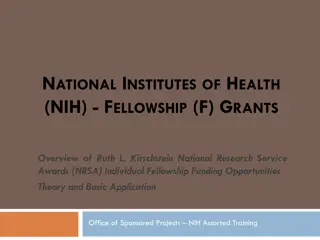India Fellowship Webinar - Case Study on Life Technical Aspects
This case study delves into the technical and regulatory challenges faced by a small life insurance company during the COVID-19 pandemic. Explore the CFO's proposal, regulatory & professional aspects, and alternative routes considered to address capital support issues.
Download Presentation

Please find below an Image/Link to download the presentation.
The content on the website is provided AS IS for your information and personal use only. It may not be sold, licensed, or shared on other websites without obtaining consent from the author.If you encounter any issues during the download, it is possible that the publisher has removed the file from their server.
You are allowed to download the files provided on this website for personal or commercial use, subject to the condition that they are used lawfully. All files are the property of their respective owners.
The content on the website is provided AS IS for your information and personal use only. It may not be sold, licensed, or shared on other websites without obtaining consent from the author.
E N D
Presentation Transcript
34th India Fellowship Webinar Date: 23.01.2021 Case Study 4 Life Technical (Group 2) Guide : Balachandra Joshi Presented By : 1. Amit Khurana 2. Palash Shah 3. Debjyoti Lahiri
Agenda Background of Case Study Regulatory and Professional Aspects Business Aspects Response to CFO s Proposal Alternative Routes Conclusion www.actuariesindia.org
Background of Case Study A small Life Insurance company - early years of setting up. Still requires capital support from shareholders for meeting expenses and solvency requirements. Covid 19 pandemic has adversely impacted the business of Shareholders and hence company is facing challenge in getting the capital support from Shareholders. www.actuariesindia.org
Background of Case Study CFO s Proposal : To release some Mathematical Reserve on temporary basis for the current quarter which can be increased again after getting the capital. www.actuariesindia.org
Background of Case Study CFO s Argument : Margin of adverse deviation (MAD) which is part of the Mathematical Reserve may be released to fulfil the above capital requirements. Reserve kept on account of cost of guarantee may be released as guarantee is not likely to bite in this year. Prevailing situation is ideal adverse situation that requires support from reserves and regulator also would understand the situation. www.actuariesindia.org
Regulatory & Professional aspects Insurance Act,1938 read with IRDAI(ALSM)Reg.2016: Sec 64 VA-Sufficiency of assets All Insurers to maintain at all times Available Solvency Margin (ASM) of not less than : 50% of Rs.100 crore i.e. minimum capital required OR 100% of Required Solvency Margin (RSM)[u/s 64VA (1)] Else Deemed to be Insolvent [u/s 64VA (2)]. Control level of Solvency-specified by Regulation- Solvency Ratio (ASM/RSM) 150% [u/s 64VA (3)]. [read with Sch. III IRDAI(ALSM)Reg.2016 Determination of Solvency Margins-Life Insurance Business ] www.actuariesindia.org
Regulatory & Professional aspects Insurance Act,1938 read with IRDAI(ALSM)Reg.2016 : Proviso to [Section 64VA (3)]: IRDAI may relax above provision if satisfied that either by reasons of : Unfavourable claim experience Sharp increase in volume of business Any other reason Compliance to cause Hardship to Insurer [However, Control level of Solvency can not be less than the minimum Solvency Capital Requirement as mentioned in Sec.64VA (1)] www.actuariesindia.org
Regulatory & Professional aspects Insurance Act,1938 read with IRDAI(ALSM)Reg.2016 : If Control level of Solvency is not maintained at any time- Insurer shall be deemed to have made default in compliance. [u/s 64VA (6)] and Insurer shall submit a Financial Plan, as per IRDAI directions Indicating Plan of Action to correct the deficiency within maximum 6 months [u/s 64VA (4)]. www.actuariesindia.org
Regulatory & Professional aspects IRDAI (ALSM) Regulations,2016: Valuation of Assets [Schedule I] Few Inadmissible assets. Remaining assets to be valued as per Regulations (PFS&AR, OFC, Investment..). Valuation of Liabilities [Schedule II] Method of determination of Mathematical reserve (MR) MR is determined for each contract by a prospective method of valuation (Gross Premium Valuation). Taking into account cost of any options and guarantee. www.actuariesindia.org
Regulatory & Professional aspects IRDAI (ALSM) Regulations,2016: Valuation of Liabilities [Schedule II] .. Based on prudent assumption of all relevant parameters. The value of such parameters shall include an appropriate margin of adverse deviation (MAD) to increase MR. Determination of Solvency Margin [Schedule III] www.actuariesindia.org
Regulatory & Professional aspects Actuarial Practice Standard(APS) 7: (Principles for determining MAD in Life Insurance Liabilities) Why MAD is required? Regulatory requirement to add MAD in Liability Valuation. To incorporate level of Prudence. Prime Policyholders Interest (including PRE) for already paid premium so that policyholders liability (as and when arises) can be met with greater certainty. Consideration-Safeguarding of existing www.actuariesindia.org
Regulatory & Professional aspects Actuarial Practice Standard(APS) 7: How much MAD is required? Exercise appropriate level of MAD. Professional Judgment in determining Consider Range of Plausible future scenarios-Reserve should be sufficient in all cases. www.actuariesindia.org
Regulatory & Professional aspects Actuarial Practice Standard(APS) 7: How much MAD is required? Low MAD: Insufficient Reserve lower Protection to Policyholders High MAD: Greater Reserve Higher Protection to Policyholders Tying up greater Capital & Reduction in Policyholders and Shareholders returns www.actuariesindia.org
Regulatory & Professional aspects Actuarial Practice Standard(APS) 7: How much MAD is required? Absolute Guarantee under all possible adverse outcome- Not possible. APS-7: Minimum margin that will generally be considered acceptable. AA-Solely responsible for the level of MAD. Not to be influenced unduly by personal opinion and ensure consideration of all plausible adverse scenarios. www.actuariesindia.org
Regulatory & Professional aspects Actuarial Practice Standard(APS) 1: Appointed Actuary (AA) has responsibilities towards his/her clients (Shareholders). AA has statutory responsibilities towards IRDAI. AA has continuing responsibility to look after the reasonable expectation of the policyholders. www.actuariesindia.org
Regulatory & Professional aspects Actuarial Practice Standard(APS) 1,2 and PCS: AA shall be responsible for maintaining required solvency margin at all times. Ensuring adequacy and completeness of the data is the area of AA. AA shall be responsible for determining best estimate assumptions and the size of MAD shall reflect the degree of confidence AA has on best estimate assumptions. As per Professional Conduct Standard(PCS), an Actuary must use best judgment in formulating advice. www.actuariesindia.org
Business Aspects Capital is being injected to finance the expense and solvency requirements. Financing of expenses and solvency arises due to the following reason: There may be expense overruns. Expenses incurred being more than the regulatory prescribed limit. www.actuariesindia.org
Business Aspects Financing of expenses and solvency arises due to the following reason: There may be huge capital expenditure, eg. Setting up IT infrastructure, Real Estate etc. incurred for setting up in initial years which is spread over few years. NB stain resulting from higher initial expenses and Required Solvency Margin requirements depending on the line of business. Expansion plan/strategic investments. www.actuariesindia.org
Business Aspects Additional capital requirements due to impact of COVID-19 may be due to following reasons: Reduction in NB Increased Per-policy expenses resulting from poor persistency Likelihood of Poor Mortality Increased IBNR claims Change in Operations with move from Offline to Online Increased need for Provision for liquidity www.actuariesindia.org
Business Aspects In absence of injection of capital : The expansion of the business may be constrained. There may be fall in the new business volume. This may lead to increase in per policy expenses. This will in turn put constraints on writing new products. May results in penal actions for non-compliance of regulatory requirements. www.actuariesindia.org
Response to the CFO MAD is an integral part of Reserve. Regulatory Requirement as per Insurance Act, 1938 and IRDAI (ALSM) regulations, 2016. Depends on the level on confidence in Best Estimate (BE)assumptions . MAD is kept over and above the BE assumptions to cover the Risk of Mis-estimation of Best Estimate (BE) assumptions. Deterioration or Adverse movement in BE. www.actuariesindia.org
Response to the CFO AA to quantify and justify MAD and demonstrate to Regulator that MAD applied provides appropriate level of Prudence and enhances degree of Protection of Policyholders Interest, from impact of adverse experience. Full range of plausible adverse scenarios have been considered. www.actuariesindia.org
Response to the CFO Any possible window for release of Reserve/MAD: There is no scope for reduction of reserve unless A huge amount of Reserve/MAD is kept well above the minimum requirements and Professional judgment proves that it may be brought to the required level. www.actuariesindia.org
Response to the CFO Any possible window for release of Reserve/MAD: However, in the given situation it is not feasible as: APS 7 prescribes the minimum MAD and Our Company might be maintaining the minimum MAD in the Mathematical Reserve. The ongoing COVID-19 situation may rather increase the need for more Reserve to cover the plausible future adverse scenario on count of Mortality, Investment, Withdrawal and Expense risk based on the current experience. www.actuariesindia.org
Response to the CFO Any possible window for release of Reserve/MAD: However, in the given situation it not feasible as: Cost of guarantee in the reserve is a provision towards likelihood of guarantee biting during the currency of the policy. Based on the experience of current year, it may not seem prudent to reduce the cost of guarantee due to increased Investment Risk. www.actuariesindia.org
Response to the CFO Any possible window for release of Reserve/MAD: However, in the given situation it not feasible as: No discretion to arbitrarily and temporarily adjust the Reserve/MAD. As per APS 4, work of the AA will be peer reviewed having regard to IRDAI requirement, relevant APS and Professional Conduct Standard. www.actuariesindia.org
Alternative routes Adjusting the expense outgoes by Postponing promotions and advertisements Negotiating with service providers Deferring other expense payout like part salary etc., if possible Reducing the New Business. Changing product mix with more weightage towards more capital efficient product. Cashing in some unrealized gain in Equity shares Investment. www.actuariesindia.org
Alternative routes Making representation to IRDAI seeking relaxation for short term from Control level of Solvency Capital Requirement if Solvency Margin is above the Minimum prescribed level by Proving that Present situation is causing hardship to Shareholders Caused by Temporary Pandemic situation Furnishing Financial plan Indication plan of action and Commitment to clear the deficiency within max.6 months www.actuariesindia.org
Conclusion As per CFO-Temporary need for alternative Capital Requirement Reserve and MAD can not be varied arbitrarily Possible only if there are already built up excess Reserve/MAD as a extra cautious approach (due to lack of historical data/experience) during initial years and Professional judgment proves that it can be brought to the required appropriate level with concurrence of IRDAI. Relaxation by IRDAI may not be easy as pandemic situation might have impacted all the Insurers in the industry and IRDAI may not wish to create expectation for other Insurers. www.actuariesindia.org
Conclusion Probable solutions having immediate relief in given situation: Cashing in some unrealized gain in Equity shares Investment. Reduce the level of New Business. Changing product mix with more weightage towards more capital efficient product. Defer the planned expenditure. Reduction in Campaign/Publicity expenses. www.actuariesindia.org
THANKS www.actuariesindia.org
